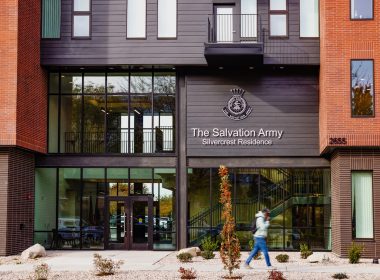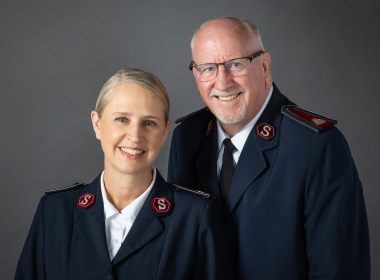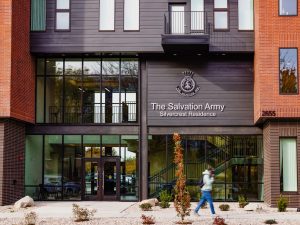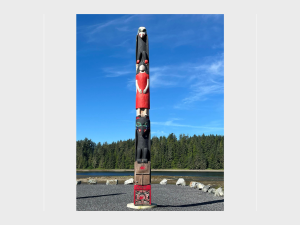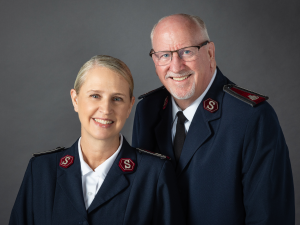Jim Sparks is The Salvation Army Mission Strategist in the Western U.S.
“Why is that causing this?”
As the Territorial Mission Strategist for The Salvation Army Western Territory, Jim Sparks often finds himself asking that question. His curiosity serves him well in this position, a new role in the Western Territory.
“I always like learning new things,” Sparks said. “I’m a curious person, so I like to dig in.”
Sparks researches future trends and cultural shifts to identify potential challenges and opportunities for The Salvation Army’s ministry. His responsibilities also include strengthening communication and systems that support the territory’s strategic mission and developing leadership training to reflect the evolving workplace and church culture.
To do this, Sparks collects and analyzes data and collaborates with other departments.
“It allows us to make better decisions based on real data,” he said.
Eight months into the role, he’s delving into the complexities surrounding issues like officer moves and their effect on the congregation.
“The inner workings of the Salvation Army can be incredibly complex,” Sparks said. “My hope is that through deep dives in data, real conversations with key stakeholders, and working collaboratively with various departments, we can collectively provide thoughtful information to decision makers and in turn provide quality resources that support the work in the field. As I have quickly found out, that involves doing some root cause analysis. Sometimes the more you dig, you see that the roots are much bigger than you anticipated.”
Territorial Program Secretary Lt. Colonel Phil Lum is optimistic about the impact of the Mission Strategist role.
“As we look to the future, Jim’s dedication to the Army’s mission and his critical thinking skills will help our territory move forward in a positive direction,” Lum said.
After growing up in The Salvation Army, Sparks first worked for the organization at Camp Mt. Crags in Calabasas, California—now Lawrence M. Daley Camp and Conference Center. From there, he went to the Territorial Youth Department, where he worked for 22 years before transitioning to Territorial Mission Strategist.
He’s witnessed The Salvation Army’s impact on individuals and communities.
“There’s no end to what The Salvation Army provides,” he said. “I love that if there is a need, that The Salvation Army is willing to take a look at that need to see if it could do something about it.
“But what has never gotten old for me is witnessing lives change, especially when people make a commitment to Christ. Seeing someone’s life take a new direction and knowing that moment will shape their future fills me with awe every time.”
As Territorial Mission Strategist, Sparks aims to equip the territory’s corps with the tools and strategies needed to serve their communities effectively while continuing to lead people to Christ, advancing The Salvation Army’s mission.
Caring Magazine asked Sparks about his goals as Territorial Mission Strategist and the challenges and opportunities ahead.
Caring Magazine (CM): How did your years in the Youth Department prepare you for this position?
Jim Sparks (JS): I think I benefited most from the relationships. For understanding The Salvation Army and its nuances, its complexity—that was found in building relationships. I have relationships with established officers starting from when they were young officers. Because I have relationships, it allows me to ask questions and to get good answers, and it allows me to have a better perspective of what the current temperature is around the territory. Because of these relationships built over time, I have an understanding of what officers go through and what they want—the realities of what’s going on. I’m able to ask questions that hopefully build trust and elicit feedback of what’s happening in our congregations, in the field.
CM: What are some of your achievements from your time in the Youth Department?
JS: I really wanted to introduce new things—and we did that. Specifically, I always wanted to explore new ways of worship and how we understand worship, and so designing meetings that were different, that had a different vibe, a different pathway than people are used to—or to challenge norms of how we think we could be growing in Christ, and are there different ways that we could do that. And we had some incredible worship services over the years. That’s really exciting because you feel like you’re opening a door for growth…I think in a lot of ways, we made some change. I could look back at some of that and say, ‘Oh, I remember when people were adamantly against that.’ And it’s kind of fun to see that it’s not only happening, but it’s serving a good purpose.
CM: What are your goals as Territorial Mission Strategist?
JS: The Salvation Army is unique because we change. We change more than most churches change. What does that mean for us?
Ultimately, my goal would be to help build a collaborative environment where strengths are leveraged so that our corps, programs, and services not only grow, but are of a high quality. Sometimes that may mean looking at a larger cultural shift. Sometimes that may mean a series of small changes that could yield larger results. Thoughtful research and relationships will be key to building such an environment.
CM: What prompted the creation of this position, a new one for the Western Territory?
JS: I think this position developed from the idea for someone to be able to come in and work with all kinds of departments and leverage the strengths of all those to foster collaboration—to be a dot connector. So many departments have their own strategies and are producing incredible resources and training. While there are great examples of collaboration, it can also be very silo-driven, and so part of my job is to go and see what everyone is doing and be able to start connecting some of those dots.
Part of the mandate is to look at what’s coming down the pipeline and to figure out what future trends are coming that might reshape how we do things. One that we are looking at currently is the rise of mental health diagnoses and how that affects the workplace and the congregation. Among 18- to 24-year-olds, 55 percent report having received a diagnosis and/or treatment for a mental illness (McKinsey Research). This group is more apt to talk openly about their mental health than previous generations, and often sets stronger boundaries. This will no doubt change parts of our workplace and congregation cultures.
CM: What might be a day in the life of the Mission Strategist?
JS: Right now it’s a lot of fact finding. Some of that means sifting through data and some is simply meeting with various departments. I have learned quickly that I didn’t know enough about what is available to us at the corps, and about the incredible resources that are being produced by Territorial Headquarters and the divisional headquarters, outside of the Youth Department. I wish I had been better at working collaboratively while I was in the youth department.
As I am gathering and understanding the resources, I am able to look for collaborative moments. One current project is with the Social Services and Corps Ministries departments, aiming to connect social services to the congregation and the congregation to our social service programs. The outcome we are looking for is that each congregation will be connected to the work that takes place in its social service program.
CM: What are some challenges you hope to address in your work?
JS: I’ve been doing deep dives into our data for corps attendance, officer moves and the frequency of moves, and what effect that has. The trouble is the deeper I go, the more questions come up…There’s just so much data. I’ve documented every move for the last 24 years. The median stay for an officer is four years at a corps. That can vary greatly, but that’s the average stay. How does this affect the corps?
Do Good:
- Get on the list for Good Words from the Good Word, a bite-sized email series from Caring Magazine to give you a boost of inspiration in 1 minute a day with a daily affirmation from Scripture. Delivered right to your inbox, it’s an email to help you start your day with goodness.

